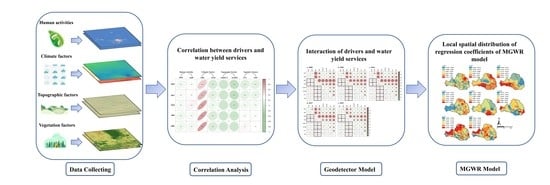Spatially Non-Stationary Relationships between Changing Environment and Water Yield Services in Watersheds of China’s Climate Transition Zones
Abstract
:1. Introduction
2. Materials and Methods
2.1. Study Area
2.2. Data Sources
2.3. Methods
2.3.1. The InVEST Water Yield Model
2.3.2. Select Potential Drivers
2.3.3. Spatial Correlation Test
2.3.4. Geodetector Model
2.3.5. Multiscale Geographically Weighted Regression Model
3. Results
3.1. Simulated Spatiotemporal Patterns of Water Yield in WRB
3.2. Identifying the Spatial Dependence of WYs in WRBs
3.3. Analysis of Geodetector Results
3.3.1. Factor Detector Analysis
3.3.2. Interaction Detector Analysis
3.4. Multiscale Geographically Weighted Regression Model Analysis
4. Discussion
4.1. The MGWR Model Can Precisely Depict the Links among the Drivers Factors and WYs in WRB
4.2. Differences in Local R2 between Basins
4.3. Drivers of WYs in WRB
4.4. Limitations and Future Work Directions
5. Conclusions
Supplementary Materials
Author Contributions
Funding
Data Availability Statement
Conflicts of Interest
References
- Costanza, R.; d’Arge, R.; De Groot, R.; Farber, S.; Grasso, M.; Hannon, B.; Limburg, K.; Naeem, S.; O’neill, R.V.; Paruelo, J. The value of the world’s ecosystem services and natural capital. Nature 1997, 387, 253–260. [Google Scholar] [CrossRef]
- Costanza, R.; De Groot, R.; Braat, L.; Kubiszewski, I.; Fioramonti, L.; Sutton, P.; Farber, S.; Grasso, M. Twenty years of ecosystem services: How far have we come and how far do we still need to go? Ecosyst. Serv. 2017, 28, 1–16. [Google Scholar] [CrossRef]
- Peng, J.; Tian, L.; Zhang, Z.; Zhao, Y.; Green, S.M.; Quine, T.A.; Liu, H.; Meersmans, J. Distinguishing the impacts of land use and climate change on ecosystem services in a karst landscape in China. Ecosyst. Serv. 2020, 46, 101199. [Google Scholar] [CrossRef]
- Liang, Y.; Hashimoto, S.; Liu, L. Integrated assessment of land-use/land-cover dynamics on carbon storage services in the Loess Plateau of China from 1995 to 2050. Ecol. Indic. 2021, 120, 106939. [Google Scholar] [CrossRef]
- Carpenter Stephen, R.; DeFries, R.; Dietz, T.; Mooney Harold, A.; Polasky, S.; Reid Walter, V.; Scholes Robert, J. Millennium Ecosystem Assessment: Research Needs. Science 2006, 314, 257–258. [Google Scholar] [CrossRef] [PubMed]
- Carpenter Stephen, R.; Mooney Harold, A.; Agard, J.; Capistrano, D.; DeFries Ruth, S.; Díaz, S.; Dietz, T.; Duraiappah Anantha, K.; Oteng-Yeboah, A.; Pereira Henrique, M.; et al. Science for managing ecosystem services: Beyond the Millennium Ecosystem Assessment. Proc. Natl. Acad. Sci. USA 2009, 106, 1305–1312. [Google Scholar] [CrossRef] [Green Version]
- Perrings, C.; Duraiappah, A.; Larigauderie, A.; Mooney, H. The biodiversity and ecosystem services science-policy interface. Science 2011, 331, 1139–1140. [Google Scholar] [CrossRef]
- Cao, Z.; Wang, S.; Luo, P.; Xie, D.; Zhu, W. Watershed Ecohydrological Processes in a Changing Environment: Opportunities and Challenges. Water 2022, 14, 1502. [Google Scholar] [CrossRef]
- Yang, Q.; Liu, G.; Casazza, M.; Dumontet, S.; Yang, Z. Ecosystem restoration programs challenges under climate and land use change. Sci. Total Environ. 2022, 807, 150527. [Google Scholar] [CrossRef]
- Ma, T.; Sun, S.; Fu, G.; Hall, J.W.; Ni, Y.; He, L.; Yi, J.; Zhao, N.; Du, Y.; Pei, T.; et al. Pollution exacerbates China’s water scarcity and its regional inequality. Nat. Commun. 2020, 11, 650. [Google Scholar] [CrossRef]
- Vanham, D.; Hoekstra, A.Y.; Wada, Y.; Bouraoui, F.; De Roo, A.; Mekonnen, M.; Van De Bund, W.; Batelaan, O.; Pavelic, P.; Bastiaanssen, W.G. Physical water scarcity metrics for monitoring progress towards SDG target 6.4: An evaluation of indicator 6.4. 2 “Level of water stress”. Sci. Total Environ. 2018, 613, 218–232. [Google Scholar] [CrossRef] [PubMed]
- Fan, M.; Shibata, H.; Chen, L. Spatial conservation of water yield and sediment retention hydrological ecosystem services across Teshio watershed, northernmost of Japan. Ecol. Complex. 2018, 33, 1–10. [Google Scholar] [CrossRef]
- Zhang, X.; Zhang, G.; Long, X.; Zhang, Q.; Liu, D.; Wu, H.; Li, S. Identifying the drivers of water yield ecosystem service: A case study in the Yangtze River Basin, China. Ecol. Indic. 2021, 132, 108304. [Google Scholar] [CrossRef]
- Vigerstol, K.L.; Aukema, J.E. A comparison of tools for modeling freshwater ecosystem services. J. Environ. Manag. 2011, 92, 2403–2409. [Google Scholar] [CrossRef]
- Li, Y.; Yao, S.; Deng, Y.; Jia, L.; Hou, M.; Gong, Z. Spatio-Temporal Study on Supply and Demand Matching of Ecosystem Water Yield Service—A Case Study of Wei River Basin. Pol. J. Environ. Stud. 2021, 30, 1677–1693. [Google Scholar] [CrossRef]
- Zhang, Y.; Zhang, B.; Ma, B.; Yao, R.; Wang, L. Evaluation of the water conservation capacity of the Weihe River Basin based on the Integrated Valuation of Ecosystem Services and Tradeoffs model. Ecohydrology 2022, 2022, e2465. [Google Scholar] [CrossRef]
- Sun, X.; Guo, H.; Lian, L.; Liu, F.; Li, B. The spatial pattern of water yield and its driving factors in Nansi Lake basin. J. Nat. Resour. 2017, 32, 669–679. [Google Scholar]
- Hao, R.; Yu, D.; Liu, Y.; Liu, Y.; Qiao, J.; Wang, X.; Du, J. Impacts of changes in climate and landscape pattern on ecosystem services. Sci. Total Environ. 2017, 579, 718–728. [Google Scholar] [CrossRef]
- Dai, E.; Wang, Y. Spatial heterogeneity and driving mechanisms of water yield service in the Hengduan Mountain region. Acta Geogr. Sin. 2020, 75, 607–619. [Google Scholar]
- Hoyer, R.; Chang, H. Assessment of freshwater ecosystem services in the Tualatin and Yamhill basins under climate change and urbanization. Appl. Geogr. 2014, 53, 402–416. [Google Scholar] [CrossRef]
- Fotheringham, A.S.; Yang, W.; Kang, W. Multiscale geographically weighted regression (MGWR). Ann. Am. Assoc. Geogr. 2017, 107, 1247–1265. [Google Scholar] [CrossRef]
- Yu, H.; Fotheringham, A.S.; Li, Z.; Oshan, T.; Kang, W.; Wolf, L.J. Inference in Multiscale Geographically Weighted Regression. Geogr. Anal. 2020, 52, 87–106. [Google Scholar] [CrossRef]
- Bennett, E.M.; Peterson, G.D.; Gordon, L.J. Understanding relationships among multiple ecosystem services. Ecol. Lett. 2009, 12, 1394–1404. [Google Scholar] [CrossRef] [PubMed]
- Wu, C.; Qiu, D.; Gao, P.; Mu, X.; Zhao, G. Application of the InVEST model for assessing water yield and its response to precipitation and land use in the Weihe River Basin, China. J. Arid Land 2022, 14, 426–440. [Google Scholar] [CrossRef]
- Yang, J.; Xie, B.P.; Zhang, D.G. Spatio-temporal variation of water yield and its response to precipitation and land use change in the Yellow River Basin based on InVEST model. J. Appl. Ecol. 2020, 31, 2731–2739. [Google Scholar]
- Jiang, C.; Li, D.Q.; Wang, D.W.; Zhang, L.B. Quantification and assessment of changes in ecosystem service in the Three-River Headwaters Region, China as a result of climate variability and land cover change. Ecol. Indic. 2016, 66, 199–211. [Google Scholar] [CrossRef]
- Yang, M.; Gao, X.; Zhao, X.; Wu, P. Scale effect and spatially explicit drivers of interactions between ecosystem services—A case study from the Loess Plateau. Sci. Total Environ. 2021, 785, 147389. [Google Scholar] [CrossRef]
- Zhu, Y.; Luo, P.; Zhang, S.; Sun, B. Spatiotemporal analysis of hydrological variations and their impacts on vegetation in semiarid areas from multiple satellite data. Remote Sens. 2020, 12, 4177. [Google Scholar] [CrossRef]
- Qiu, D.; Wu, C.; Mu, X.; Zhao, G.; Gao, P. Changes in extreme precipitation in the Wei River Basin of China during 1957–2019 and potential driving factors. Theor. Appl. Climatol. 2022, 149, 915–929. [Google Scholar] [CrossRef]
- Liu, J.; Xia, J.; She, D.; Li, L.; Wang, Q.; Zou, L. Evaluation of six satellite-based precipitation products and their ability for capturing characteristics of extreme precipitation events over a climate transition area in China. Remote Sens. 2019, 11, 1477. [Google Scholar] [CrossRef] [Green Version]
- Li, C.; Zhang, H.; Gong, X.; Wei, X.; Yang, J. Precipitation trends and alteration in Wei River Basin: Implication for water resources management in the transitional zone between plain and loess plateau, China. Water 2019, 11, 2407. [Google Scholar] [CrossRef] [Green Version]
- 2022 New Urbanization and Key Tasks of Urban-Rural Integration Development. Available online: https://www.ndrc.gov.cn/xxgk/zcfb/tz/202203/t20220317_1319455.html?code=&state=123 (accessed on 20 May 2022).
- Yang, J.; Huang, X. The 30 m annual land cover dataset and its dynamics in China from 1990 to 2019. Earth Syst. Sci. Data 2021, 13, 3907–3925. [Google Scholar] [CrossRef]
- InVEST 3.2.0 User‘s Guide. Available online: http://naturalcapitalproject-stanford-edu-s.vpn.chd.edu.cn:8080/software/invest (accessed on 16 March 2022).
- Fu, B. On the calculation of the evaporation from land surface. Sci. Atmos. Sin. 1981, 5, 23–31. [Google Scholar]
- Zhang, L.; Hickel, K.; Dawes, W.; Chiew, F.H.; Western, A.; Briggs, P. A rational function approach for estimating mean annual evapotranspiration. Water. Resour. Res. 2004, 40, W02502. [Google Scholar] [CrossRef]
- Hargreaves, G.H.; Allen, R.G. History and evaluation of Hargreaves evapotranspiration equation. J. Irrig. Drain. Eng. 2003, 129, 53–63. [Google Scholar] [CrossRef]
- Deng, C.; Zhu, D.; Nie, X.; Liu, C.; Zhang, G.; Liu, Y.; Li, Z.; Wang, S.; Ma, Y. Precipitation and urban expansion caused jointly the spatiotemporal dislocation between supply and demand of water provision service. J. Environ. Manag. 2021, 299, 113660. [Google Scholar] [CrossRef]
- Zhao, H.; Liu, Y.; Gu, T.; Zheng, H.; Wang, Z.; Yang, D. Identifying Spatiotemporal Heterogeneity of PM2.5 Concentrations and the Key Influencing Factors in the Middle and Lower Reaches of the Yellow River. Remote Sens. 2022, 14, 2643. [Google Scholar] [CrossRef]
- Lei, C.; Wang, Q.; Wang, Y.; Han, L.; Yuan, J.; Yang, L.; Xu, Y. Spatially non-stationary relationships between urbanization and the characteristics and storage-regulation capacities of river systems in the Tai Lake Plain, China. Sci. Total Environ. 2022, 824, 153684. [Google Scholar] [CrossRef]
- Getis, A. Spatial autocorrelation. In Handbook of Applied Spatial Analysis; Springer: Berlin/Heidelberg, Germany, 2010; pp. 255–278. [Google Scholar]
- Anselin, L.; Rey, S.J. Modern Spatial Econometrics in Practice: A Guide to GeoDa, GeoDaSpace and PySAL; GeoDa Press LLC: Chicago, IL, USA, 2014; pp. 30–121. [Google Scholar]
- Wang, J.-F.; Zhang, T.-L.; Fu, B.-J. A measure of spatial stratified heterogeneity. Ecol. Indic. 2016, 67, 250–256. [Google Scholar] [CrossRef]
- Zhao, R.; Zhan, L.; Yao, M.; Yang, L. A geographically weighted regression model augmented by Geodetector analysis and principal component analysis for the spatial distribution of PM2.5. Sustain. Cities Soc. 2020, 56, 102106. [Google Scholar] [CrossRef]
- Wang, J.-F.; Hu, Y. Environmental health risk detection with GeogDetector. Environ. Model. Softw. 2012, 33, 114–115. [Google Scholar] [CrossRef]
- Wang, C.; Wang, J.; Naudiyal, N.; Wu, N.; Cui, X.; Wei, Y.; Chen, Q. Multiple Effects of Topographic Factors on Spatio-Temporal Variations of Vegetation Patterns in the Three Parallel Rivers Region, Southeast Qinghai-Tibet Plateau. Remote Sens. 2022, 14, 151. [Google Scholar] [CrossRef]
- Oshan, T.M.; Li, Z.; Kang, W.; Wolf, L.J.; Fotheringham, A.S. Mgwr: A Python implementation of multiscale geographically weighted regression for investigating process spatial heterogeneity and scale. ISPRS Int. J. Geoinf. 2019, 8, 269. [Google Scholar] [CrossRef] [Green Version]
- Li, Z.; Fotheringham, A.S. Computational improvements to multi-scale geographically weighted regression. Int. J. Geogr. Inform. Sci. 2020, 34, 1378–1397. [Google Scholar] [CrossRef]
- Wang, L.; Wang, S.; Zhou, Y.; Liu, W.; Hou, Y.; Zhu, J.; Wang, F. Mapping population density in China between 1990 and 2010 using remote sensing. Remote Sens. Environ. 2018, 210, 269–281. [Google Scholar] [CrossRef]
- Waters, C.N.; Zalasiewicz, J.; Summerhayes, C.; Barnosky, A.D.; Poirier, C.; Gałuszka, A.; Cearreta, A.; Edgeworth, M.; Ellis, E.C.; Ellis, M. The Anthropocene is functionally and stratigraphically distinct from the Holocene. Science 2016, 351, aad2622. [Google Scholar] [CrossRef] [PubMed]
- Wu, T.; Zhou, L.; Jiang, G.; Meadows, M.E.; Zhang, J.; Pu, L.; Wu, C.; Xie, X. Modelling Spatial Heterogeneity in the Effects of Natural and Socioeconomic Factors, and Their Interactions, on Atmospheric PM2.5 Concentrations in China from 2000–2015. Remote Sens. 2021, 13, 2152. [Google Scholar] [CrossRef]
- Liu, H.; Zhan, Q.; Gao, S.; Yang, C. Seasonal Variation of the Spatially Non-Stationary Association Between Land Surface Temperature and Urban Landscape. Remote Sens. 2019, 11, 1016. [Google Scholar] [CrossRef] [Green Version]
- Niu, L.; Zhang, Z.; Peng, Z.; Liang, Y.; Liu, M.; Jiang, Y.; Wei, J.; Tang, R. Identifying Surface Urban Heat Island Drivers and Their Spatial Heterogeneity in China’s 281 Cities: An Empirical Study Based on Multiscale Geographically Weighted Regression. Remote Sens. 2021, 13, 4428. [Google Scholar] [CrossRef]
- Hu, B.; Kang, F.; Han, H.; Cheng, X.; Li, Z. Exploring drivers of ecosystem services variation from a geospatial perspective: Insights from China’s Shanxi Province. Ecol. Indic. 2021, 131, 108188. [Google Scholar] [CrossRef]
- Tu, J. Spatially varying relationships between land use and water quality across an urbanization gradient explored by geographically weighted regression. Appl. Geogr. 2011, 31, 376–392. [Google Scholar] [CrossRef]
- Wang, X.; Fu, X.; Chu, B.; Li, Y.; Yan, Y.; Feng, X. Spatio-temporal variation of water yield and its driving factors in Qinling Mountains barrier region. J. Nat. Resour. 2021, 36, 2507–2521. [Google Scholar] [CrossRef]
- Li, C.; Zhao, J. Investigating the spatiotemporally varying correlation between urban spatial patterns and ecosystem services: A case study of Nansihu Lake Basin, China. ISPRS Int. J. Geoinf. 2019, 8, 346. [Google Scholar] [CrossRef] [Green Version]
- Tran, D.X.; Pearson, D.; Palmer, A.; Lowry, J.; Gray, D.; Dominati, E.J. Quantifying spatial non-stationarity in the relationship between landscape structure and the provision of ecosystem services: An example in the New Zealand hill country. Sci. Total Environ. 2022, 808, 152126. [Google Scholar] [CrossRef]
- Qi, Y.; Lian, X.; Wang, H.; Zhang, J.; Yang, R. Dynamic mechanism between human activities and ecosystem services: A case study of Qinghai lake watershed, China. Ecol. Indic. 2020, 117, 106528. [Google Scholar] [CrossRef]
- Goyal, M.K.; Khan, M. Assessment of spatially explicit annual water-balance model for Sutlej River Basin in eastern Himalayas and Tungabhadra River Basin in peninsular India. Hydrol. Res. 2017, 48, 542–558. [Google Scholar] [CrossRef] [Green Version]
- Li, J.; Dong, S.; Li, Y.; Wang, Y.; Li, Z.; Li, F. Effects of land use change on ecosystem services in the China–Mongolia–Russia economic corridor. J. Clean. Prod. 2022, 360, 132175. [Google Scholar] [CrossRef]
- Legesse, D.; Vallet-Coulomb, C.; Gasse, F. Hydrological response of a catchment to climate and land use changes in Tropical Africa: Case study South Central Ethiopia. J. Hydrol. 2003, 275, 67–85. [Google Scholar] [CrossRef]
- Zhu, W.; Wang, S.; Luo, P.; Zha, X.; Cao, Z.; Lyu, J.; Zhou, M.; He, B.; Nover, D. A Quantitative Analysis of the Influence of Temperature Change on the Extreme Precipitation. Atmosphere 2022, 13, 612. [Google Scholar] [CrossRef]
- Jiang, Y.; Xu, L.; Yang, G.; Ren, G. Microclimate effects under different forest-grass rehabilitation of vegetation models in summer. Agric. Res. Arid. Areas 2007, 25, 162–174. [Google Scholar]
- Wang, S.; Cao, Z.; Luo, P.; Zhu, W. Spatiotemporal Variations and Climatological Trends in Precipitation Indices in Shaanxi Province, China. Atmosphere 2022, 13, 744. [Google Scholar] [CrossRef]
- Zhao, Y.; Feng, Q.; Lu, A. Spatiotemporal variation in vegetation coverage and its driving factors in the Guanzhong Basin, NW China. Ecol. Inform. 2021, 64, 101371. [Google Scholar] [CrossRef]
- Kaufmann, R.K.; Seto, K.C.; Schneider, A.; Liu, Z.; Zhou, L.; Wang, W. Climate response to rapid urban growth: Evidence of a human-induced precipitation deficit. J. Clim. 2007, 20, 2299–2306. [Google Scholar] [CrossRef]
- Suriya, S.; Mudgal, B.V. Impact of urbanization on flooding: The Thirusoolam sub watershed—A case study. J. Hydrol. 2012, 412–413, 210–219. [Google Scholar] [CrossRef]
- Chen, H.; Huang, J.J.; Dash, S.S.; McBean, E.; Wei, Y.Z.; Li, H. Assessing the impact of urbanization on urban evapotranspiration and its components using a novel four-source energy balance model. Agric. For. Meteorol. 2022, 316, 108853. [Google Scholar] [CrossRef]
- Xu, J.; Liu, S.; Zhao, S.; Wu, X.; Hou, X.; An, Y.; Shen, Z. Spatiotemporal dynamics of water yield service and its response to urbanisation in the Beiyun river Basin, Beijing. Sustainability 2019, 11, 4361. [Google Scholar] [CrossRef] [Green Version]
- Cao, S.; Chen, L.; Yu, X. Impact of China’s Grain for Green Project on the landscape of vulnerable arid and semi-arid agricultural regions: A case study in northern Shaanxi Province. J. Appl. Ecol. 2009, 46, 536–543. [Google Scholar] [CrossRef]
- Hamel, P.; Guswa, A.J. Uncertainty analysis of a spatially explicit annual water-balance model: Case study of the Cape Fear basin, North Carolina. Hydrol. Earth Syst. Sci. 2015, 19, 839–853. [Google Scholar] [CrossRef] [Green Version]
- Asadi Oskouei, E.; Delsouz Khaki, B.; Kouzegaran, S.; Navidi, M.N.; Haghighatd, M.; Davatgar, N.; Lopez-Baeza, E. Mapping Climate Zones of Iran Using Hybrid Interpolation Methods. Remote Sens. 2022, 14, 2632. [Google Scholar] [CrossRef]
- Dennedy-Frank, P.J.; Muenich, R.L.; Chaubey, I.; Ziv, G. Comparing two tools for ecosystem service assessments regarding water resources decisions. J. Environ. Manag. 2016, 177, 331–340. [Google Scholar] [CrossRef] [Green Version]
- Wang, Y.W.; Zhao, N. Evaluation of Eight High-Resolution Gridded Precipitation Products in the Heihe River Basin, Northwest China. Remote Sens. 2022, 14, 1458. [Google Scholar] [CrossRef]
- Luo, P.; Luo, M.; Li, F.; Qi, X.; Huo, A.; Wang, Z.; He, B.; Takara, K.; Nover, D. Urban flood numerical simulation: Research, methods and future perspectives. Environ. Model. Softw. 2022, 105478. [Google Scholar] [CrossRef]
- Luo, P.; Zheng, Y.; Wang, Y.; Zhang, S.; Yu, W.; Zhu, X.; Huo, A.; Wang, Z.; He, B.; Nover, D. Comparative Assessment of Sponge City Constructing in Public Awareness, Xi’an, China. Sustainability 2022, 14, 11653. [Google Scholar] [CrossRef]
- Luo, P.; Liu, L.; Wang, S.; Ren, B.; He, B.; Nover, D. Influence assessment of new Inner Tube Porous Brick with absorbent concrete on urban floods control. Case Stud. Constr. Mat. 2022, 17, e01236. [Google Scholar] [CrossRef]
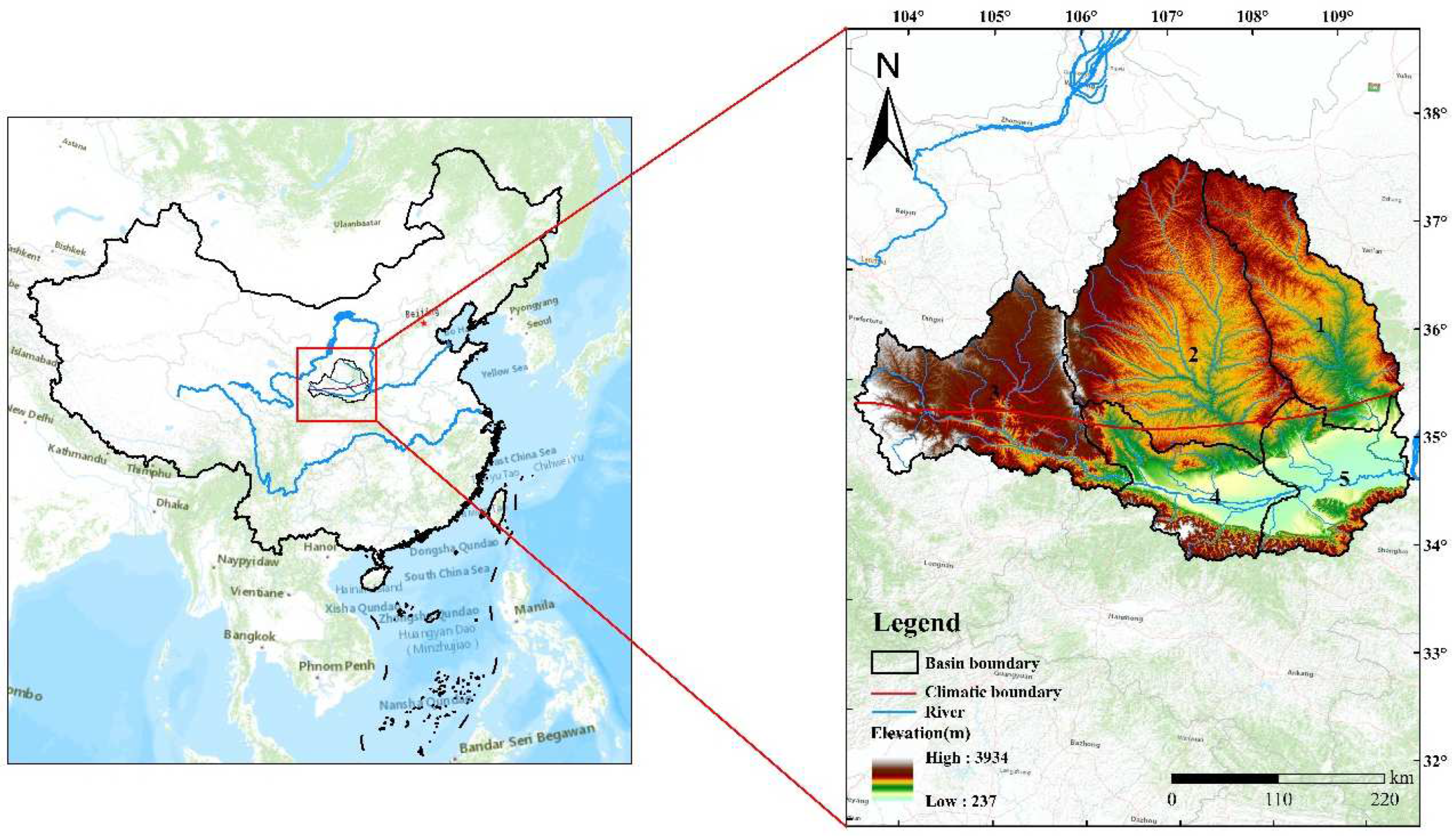
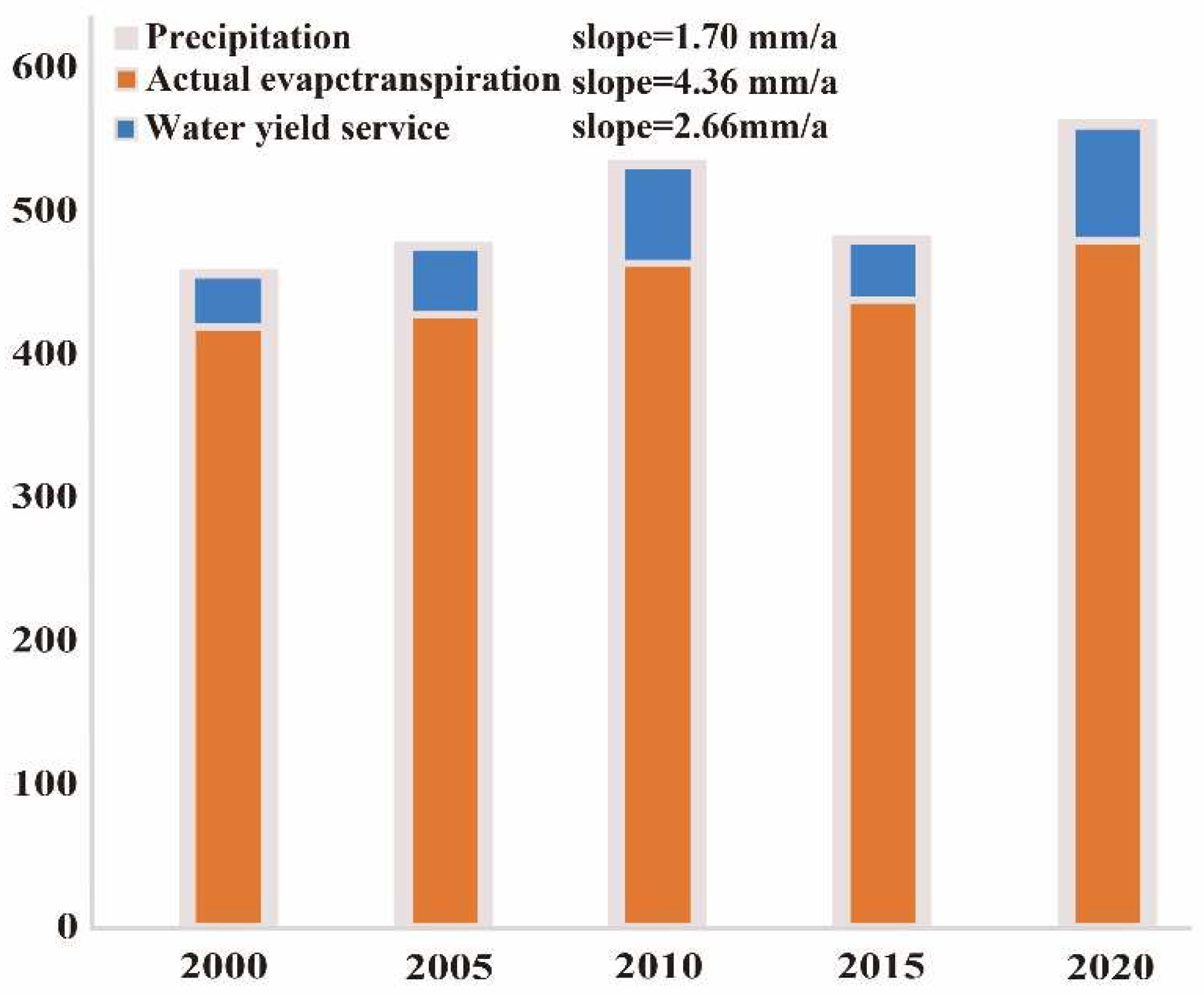

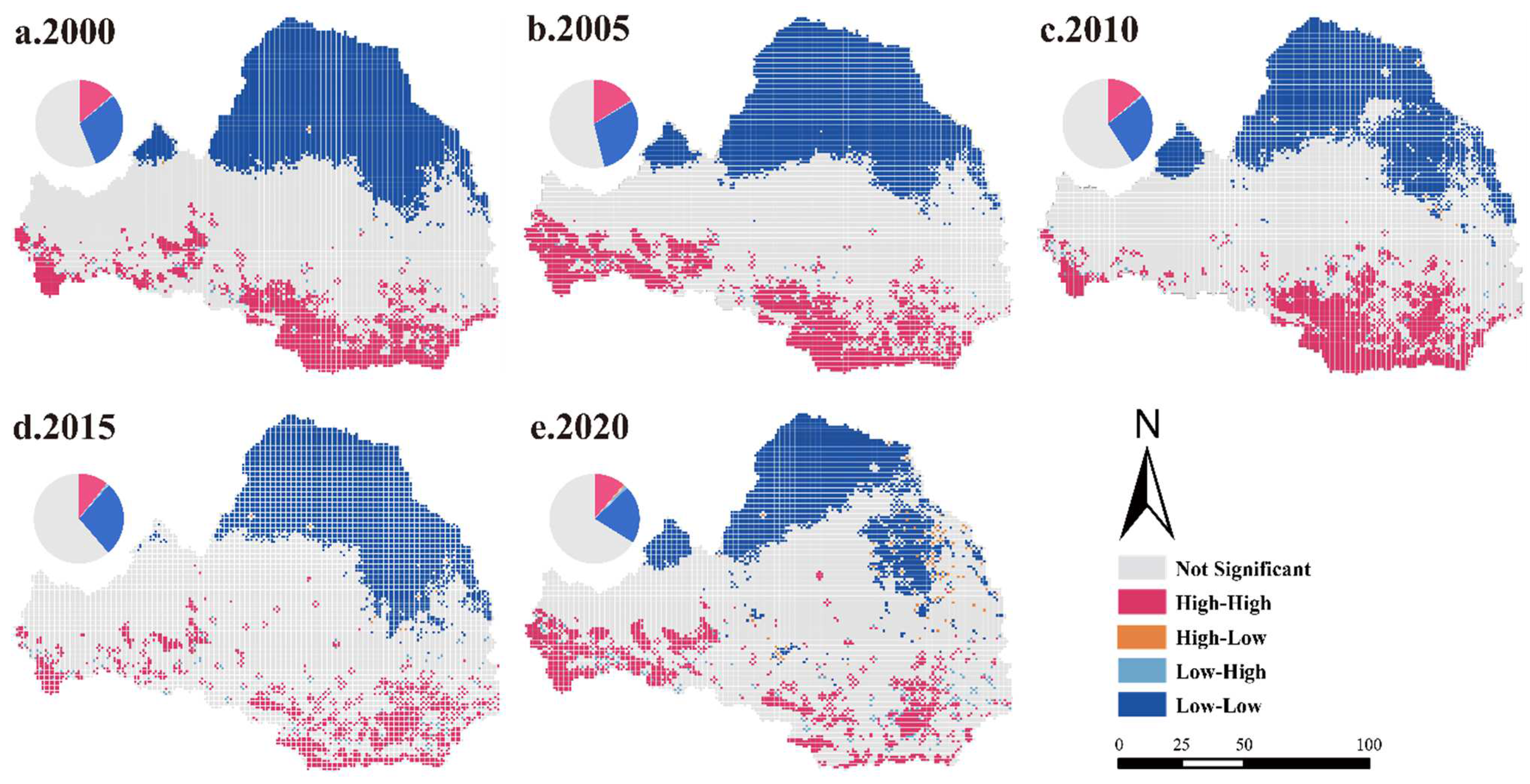

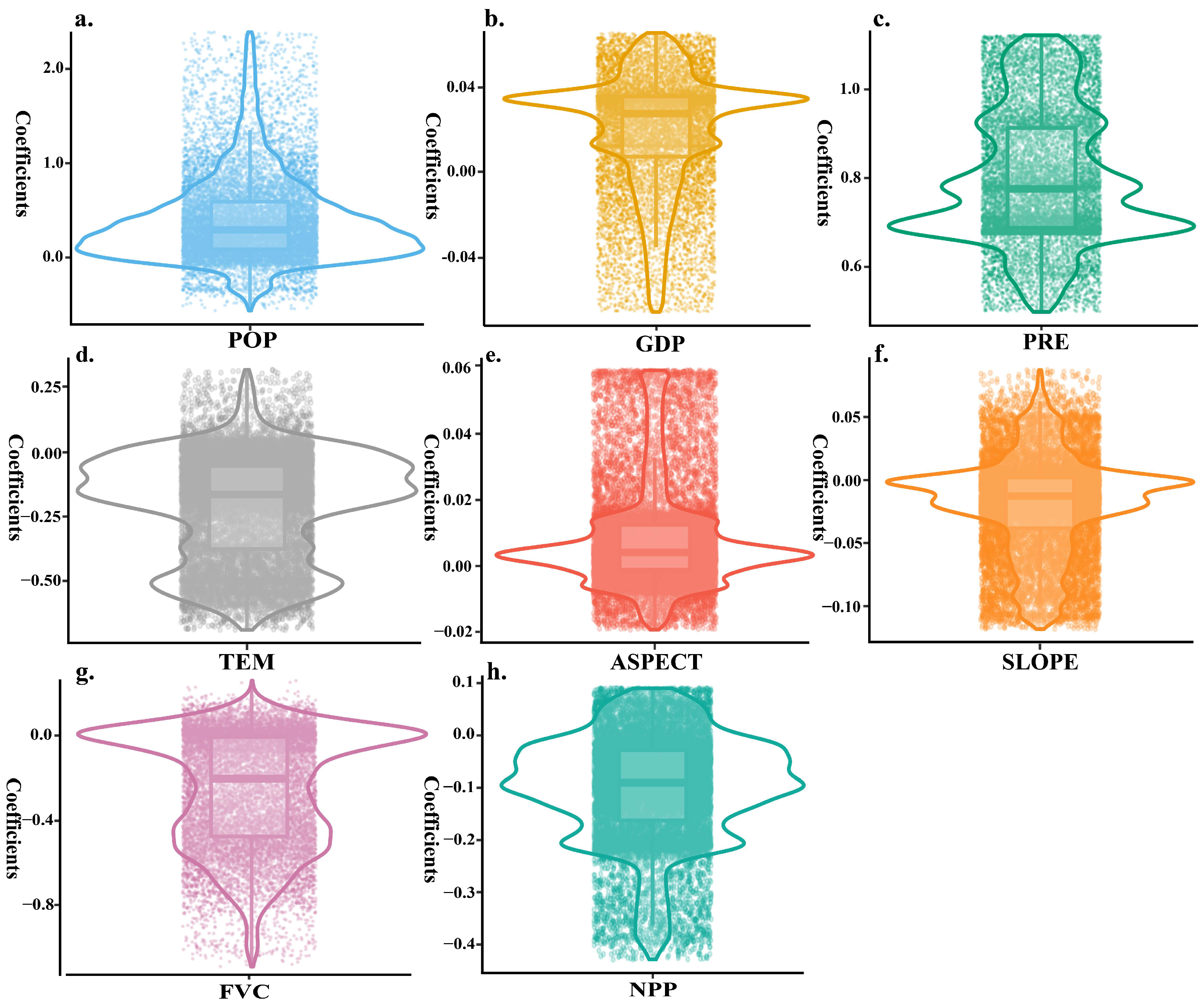
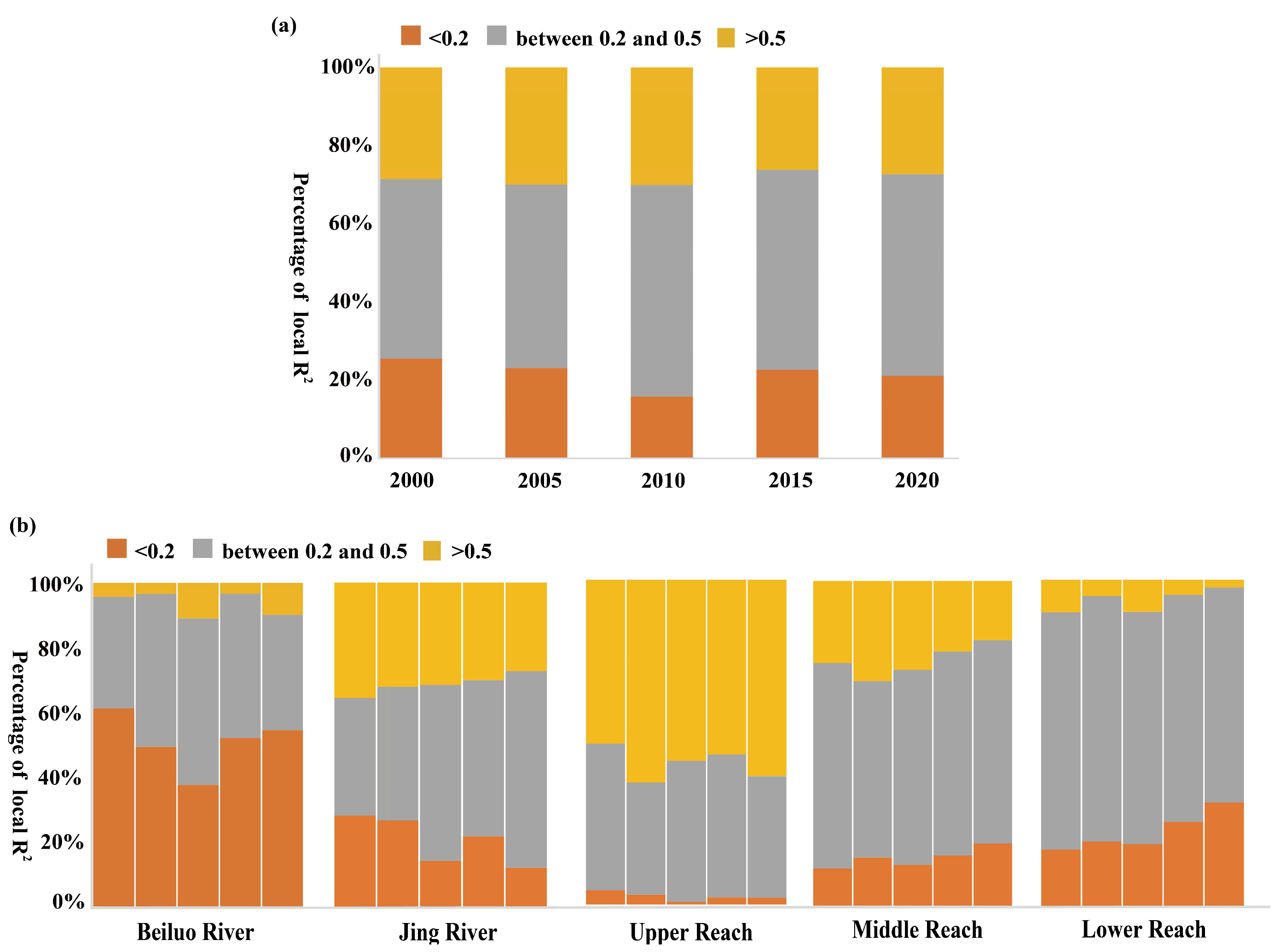

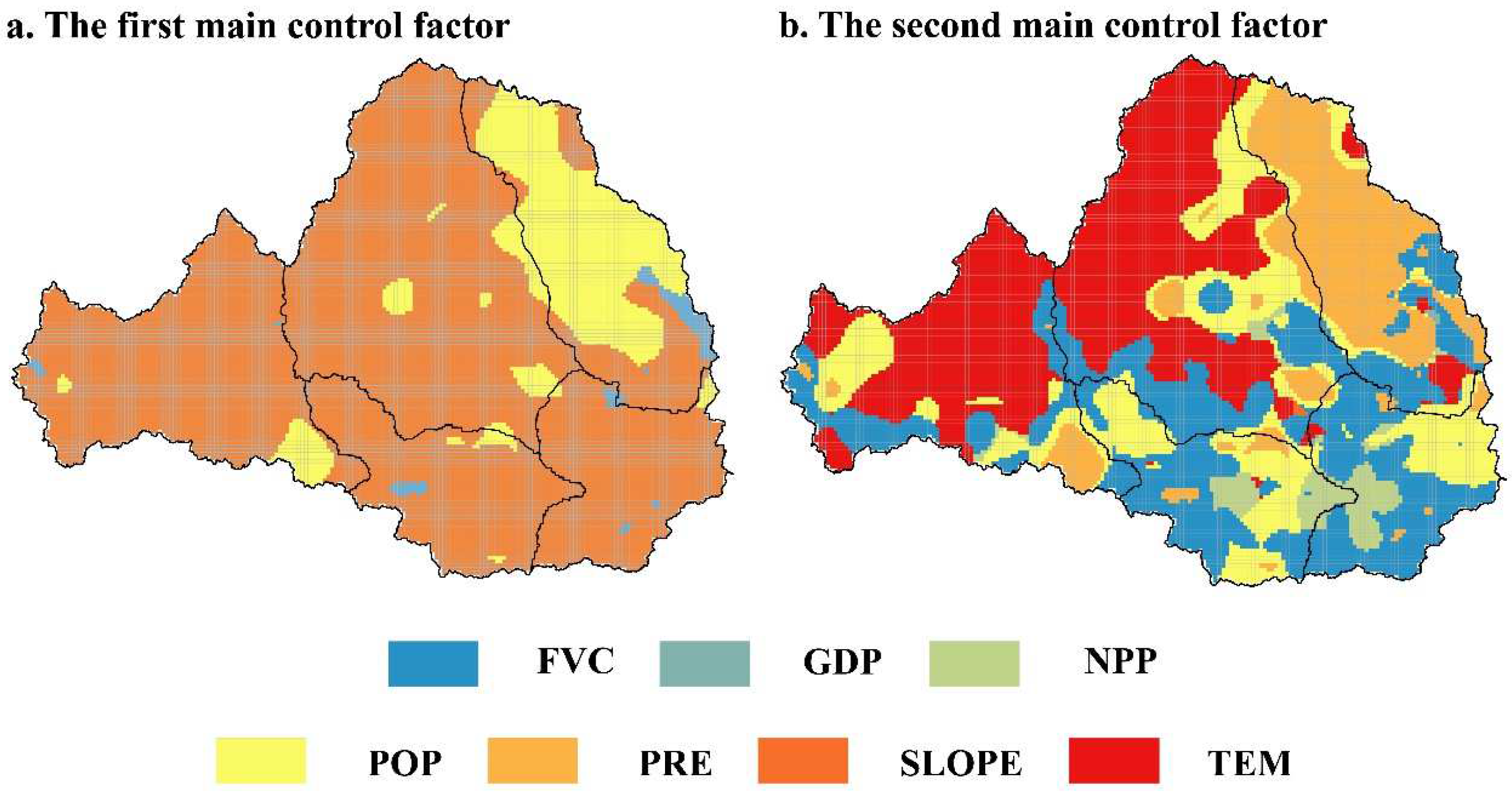
| Data | Min | Max | Unit | Type | Resolution | Source |
|---|---|---|---|---|---|---|
| Precipitation | 312.2 | 1172.6 | mm | Raster | 1 km | National Earth System Science Data Center (http://www.geodata.cn/) (accessed on 16 March 2022) |
| Temperature | −1.7 | 15.6 | °C | Raster | 1 km | National Earth System Science Data Center (http://www.geodata.cn/) (accessed on 16 March 2022) |
| Land Use and Land Cover (LULC) data | - | - | - | Raster | 30 m | [33] |
| DEM | 237 | 3934 | m | Raster | 30 m | Geospatial Data Cloud (http://www.gscloud.cn) (accessed on 16 March 2022) |
| Soil Data | - | - | - | Raster | 1 km | Harmonized World Soil Database (http://westdc.westgis.ac.cn) (accessed on 16 March 2022) |
| GDP | 2.55 | 37,028.3 | CNY/km2 | Raster | 1 km | Resource and Environment Science Data Center, Chinese Academy of Sciences (http://www.resdc.cn/) (accessed on 16 March 2022) |
| Population | 0 | 81,139.9 | People/km2 | Raster | 1 km | Resource and Environment Science Data Center, Chinese Academy of Sciences (http://www.resdc.cn/) (accessed on 16 March 2022) |
| FVC | 0 | 1 | - | Raster | 250 m | MODIS (http://modis.gsfc.nasa.gov/) (accessed on 16 March 2022) |
| NPP | 77.7 | 1164.1 | - | Raster | 500 m | MODIS (http://modis.gsfc.nasa.gov/) (accessed on 16 March 2022) |
| Judgments Based | Type of Interaction |
|---|---|
| q (X1 ∩ X2) < min(q(X1), q(X2)) | Non-linear reduction |
| min(q(X1), q(X2)) < q (X1 ∩ X2) < max(q(X1), q(X2)) | Single-factor non-linear reduction |
| q (X1 ∩ X2) > max(q(X1), q(X2)) | Two-factor enhancement |
| q (X1 ∩ X2) = q(X1) + q(X2) | Independent |
| q (X1 ∩ X2) > q(X1) + q(X2) | Non-linear enhancement |
| Year | Moran’s I | Z-Score | p-Value |
|---|---|---|---|
| 2000 | 0.782 | 134.882 | 0.00 |
| 2005 | 0.810 | 142.332 | 0.00 |
| 2010 | 0.769 | 140.161 | 0.00 |
| 2015 | 0.689 | 133.644 | 0.00 |
| 2020 | 0.686 | 149.465 | 0.00 |
| Factors | 2000 | 2005 | 2010 | 2015 | 2020 | |
|---|---|---|---|---|---|---|
| Human activities | POP | 0.05 ** | 0.063 ** | 0.061 ** | 0.065 ** | 0.05 ** |
| GDP | 0.039 ** | 0.142 ** | 0.184 ** | 0.148 ** | 0.093 ** | |
| Climatic factors | PRE | 0.703 ** | 0.495 ** | 0.615 ** | 0.56 ** | 0.371 ** |
| TEM | 0.283 ** | 0.302 ** | 0.267 ** | 0.31 ** | 0.244 ** | |
| Topography factors | ASPECT | 0.0014 ** | 0.0027 ** | 0.0027 ** | 0.0027 ** | 0.058 ** |
| SLOPE | 0.0355 ** | 0.057 ** | 0.054 ** | 0.057 ** | 0.038 ** | |
| Vegetative factors | FVC | 0.173 ** | 0.079 ** | 0.087 ** | 0.079 ** | 0.0456 ** |
| NPP | 0.246 ** | 0.169 ** | 0.188 ** | 0.176 ** | 0.18 ** |
| Variables | 2000 | 2005 | 2010 | 2015 | 2020 | |||||
|---|---|---|---|---|---|---|---|---|---|---|
| BW 1 | NLU 2 | BW | NLU | BW | NLU | BW | NLU | BW | NLU | |
| POP | 341 | 44 | 343 | 44 | 277 | 54 | 277 | 54 | 280 | 54 |
| GDP | 15,015 | 1 | 15,015 | 1 | 15,015 | 1 | 15,015 | 1 | 5430 | 3 |
| PRE | 3597 | 4 | 3281 | 5 | 4018 | 4 | 4606 | 3 | 1937 | 8 |
| TEM | 70 | 215 | 222 | 68 | 146 | 103 | 264 | 57 | 336 | 45 |
| ASPECT | 1704 | 9 | 2629 | 6 | 3819 | 4 | 15,012 | 1 | 3599 | 4 |
| SLOPE | 2220 | 7 | 1317 | 11 | 1739 | 8 | 2030 | 7 | 1037 | 14 |
| FVC | 379 | 40 | 67 | 224 | 89 | 169 | 89 | 169 | 100 | 150 |
| NPP | 102 | 147 | 426 | 35 | 824 | 18 | 777 | 19 | 577 | 26 |
| R2 | Adjusted R2 | AIC | AICc | ||
|---|---|---|---|---|---|
| 2000 | OLS | 0.715 | 0.714 | 23,803.256 | 23,805.271 |
| GWR | 0.828 | 0.817 | 18,168.077 | 18,005.001 | |
| MGWR | 0.838 | 0.821 | 18,471.733 | 18,127.638 | |
| 2005 | OLS | 0.730 | 0.730 | 22,978.377 | 22,980.392 |
| GWR | 0.847 | 0.837 | 16,320.636 | 16,341.024 | |
| MGWR | 0.854 | 0.840 | 16,220.721 | 16,341.024 | |
| 2010 | OLS | 0.716 | 0.715 | 23,755.317 | 23,757.332 |
| GWR | 0.808 | 0.797 | 19,522.113 | 19,720.232 | |
| MGWR | 0.816 | 0.801 | 19,462.883 | 19,554.417 | |
| 2015 | OLS | 0.591 | 0.591 | 29,204.394 | 29,206.409 |
| GWR | 0.723 | 0.709 | 24,772.698 | 24,947.926 | |
| MGWR | 0.737 | 0.716 | 24,782.240 | 24,857.002 | |
| 2020 | OLS | 0.541 | 0.541 | 30,941.700 | 30,943.714 |
| GWR | 0.691 | 0.677 | 26,302.039 | 26,363.564 | |
| MGWR | 0.705 | 0.685 | 26,209.412 | 26,343.399 | |
Publisher’s Note: MDPI stays neutral with regard to jurisdictional claims in published maps and institutional affiliations. |
© 2022 by the authors. Licensee MDPI, Basel, Switzerland. This article is an open access article distributed under the terms and conditions of the Creative Commons Attribution (CC BY) license (https://creativecommons.org/licenses/by/4.0/).
Share and Cite
Cao, Z.; Zhu, W.; Luo, P.; Wang, S.; Tang, Z.; Zhang, Y.; Guo, B. Spatially Non-Stationary Relationships between Changing Environment and Water Yield Services in Watersheds of China’s Climate Transition Zones. Remote Sens. 2022, 14, 5078. https://doi.org/10.3390/rs14205078
Cao Z, Zhu W, Luo P, Wang S, Tang Z, Zhang Y, Guo B. Spatially Non-Stationary Relationships between Changing Environment and Water Yield Services in Watersheds of China’s Climate Transition Zones. Remote Sensing. 2022; 14(20):5078. https://doi.org/10.3390/rs14205078
Chicago/Turabian StyleCao, Zhe, Wei Zhu, Pingping Luo, Shuangtao Wang, Zeming Tang, Yuzhu Zhang, and Bin Guo. 2022. "Spatially Non-Stationary Relationships between Changing Environment and Water Yield Services in Watersheds of China’s Climate Transition Zones" Remote Sensing 14, no. 20: 5078. https://doi.org/10.3390/rs14205078
APA StyleCao, Z., Zhu, W., Luo, P., Wang, S., Tang, Z., Zhang, Y., & Guo, B. (2022). Spatially Non-Stationary Relationships between Changing Environment and Water Yield Services in Watersheds of China’s Climate Transition Zones. Remote Sensing, 14(20), 5078. https://doi.org/10.3390/rs14205078








